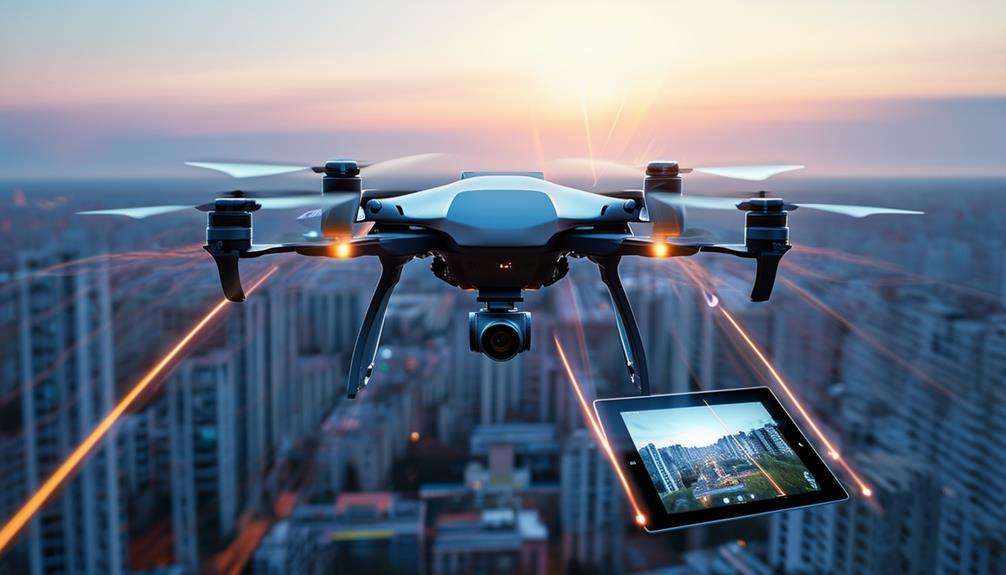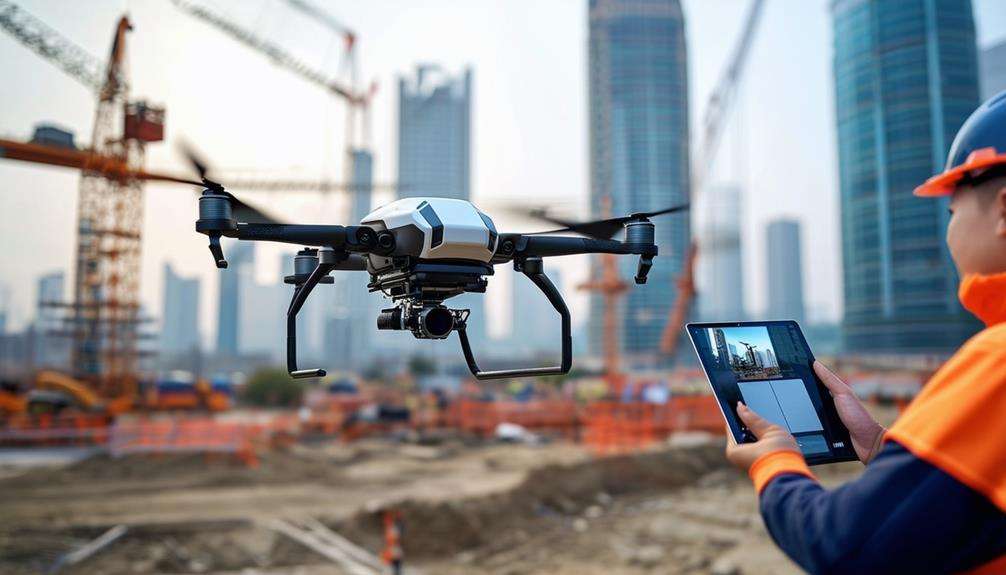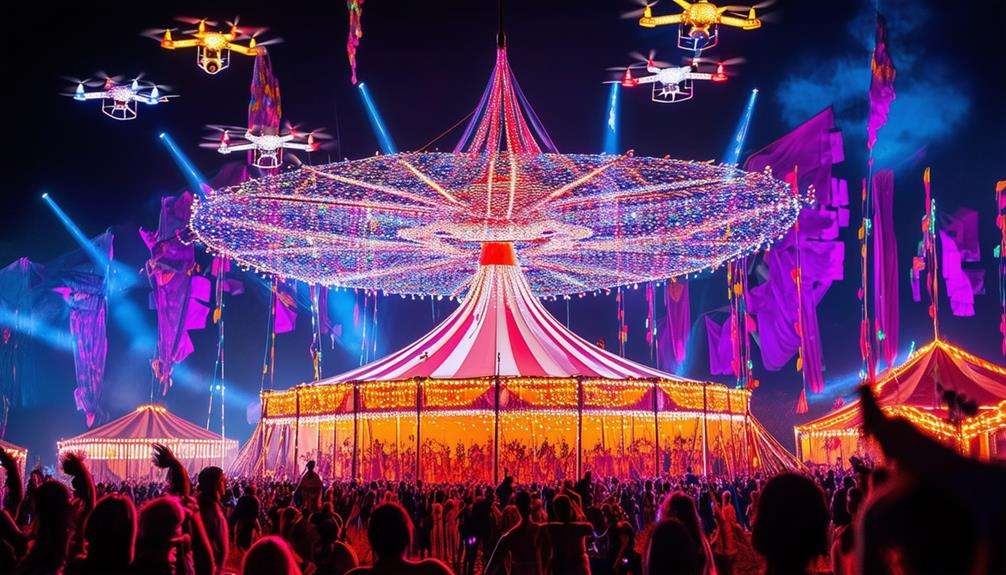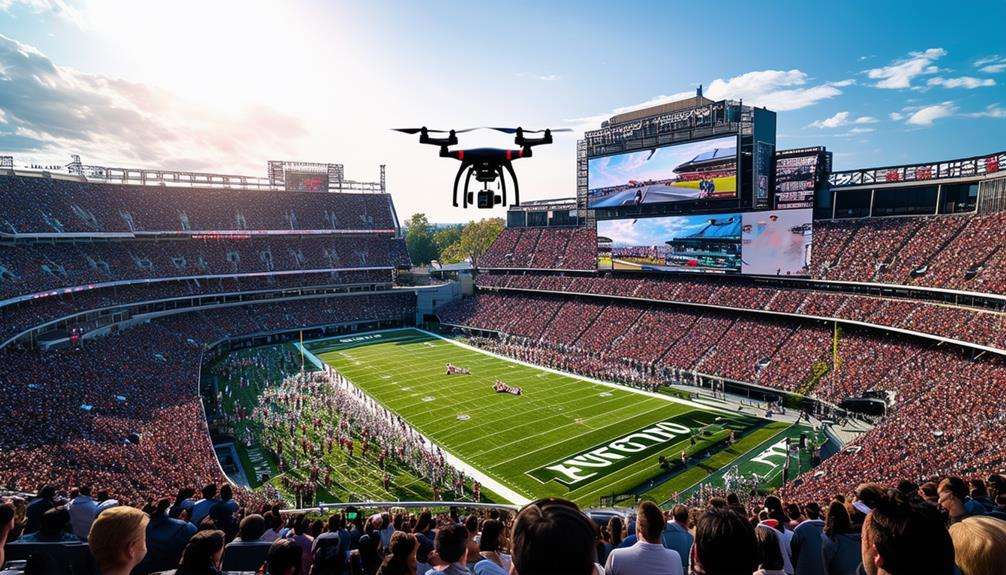How Drones Transmit Live Video Feeds

When exploring how drones transmit live video feeds, you'll encounter a variety of transmission systems tailored to different needs. These range from plug-and-play solutions like Panasonic's Press-It for straightforward setup to DJI's advanced encrypted connections for secure streaming.
These systems often utilize HDMI and SDI connections, ensuring clear transmission over varying distances. Software solutions such as DroneSense and Dejero further enhance capabilities with features like cloud-based mapping and high-quality broadcasting. But how do these technologies converge to make drones indispensable for real-time monitoring and decision-making? Let's delve into the details.
Transmission Systems Overview

When evaluating drone video transmission systems, you'll find a range of options, from simple plug-and-play setups to sophisticated, low-latency solutions.
Plug-and-Play Systems
Panasonic's Press-It system is an excellent example of a straightforward, plug-and-play video transmission solution. It offers easy-to-use, HDMI-based video transmission up to 100 feet. This setup is ideal for users seeking a hassle-free solution that requires minimal configuration.
Advanced Low-Latency Systems
On the more advanced end, DJI's video transmission system provides low-latency, encrypted point-to-point connections up to 20,000 feet. This makes it perfect for applications requiring real-time video and live streaming over long distances. The DJI system supports both SDI and HDMI relay options, which can be integrated directly into your drone controller, offering a versatile and secure connection.
Live Streaming and Enhanced Capabilities
For those interested in live streaming, DJI Flight Hub 2 software offers additional capabilities like cloud mapping, annotations, and data management, enhancing the real-time video experience. Public safety agencies can benefit from platforms like DroneSense, which enable live video feed sharing via one-time links, making it invaluable for coordinated operations. Dejero's broadcasting solution ensures high-quality streaming even on congested networks, using cellular bonding technology to keep live streams uninterrupted. These diverse systems cater to different needs, from simple setups to complex, high-performance solutions, ensuring that you can find the right fit for your specific requirements.
HDMI and SDI Connections
HDMI and SDI connections are crucial for transmitting high-quality video feeds from drones to capture devices and production setups. HDMI connections are widely used for direct video output from drones to various capture devices, ensuring a clear, sharp live stream with minimal hassle. Many DJI controllers come equipped with HDMI output ports, simplifying the connection of your drone directly to a monitor or recording device.
Conversely, SDI connections are often favored in professional environments due to their robustness and longer transmission distances. If your production setup relies on HDMI, an SDI to HDMI converter becomes essential. These converters facilitate the integration of drones with SDI outputs into HDMI-based workflows, preserving the high-quality video signal without loss during the conversion process.
Software Solutions

Exploring software solutions can significantly enhance the live video streaming capabilities of your drone operations. With the right software, you can improve the quality and reliability of your video transmission, regardless of the drone models you're using. For instance, DroneSense is a popular platform among public safety agencies, supporting live streaming from different drone models. It offers an integrated solution that makes real-time video sharing seamless and efficient.
Dejero provides a robust streaming solution by combining both software and hardware, specifically catering to the broadcasting industry. This ensures high-quality video transmission even in challenging environments. DJI Flight Hub 2, another powerful software solution, facilitates live streaming along with cloud mapping, annotations, and data management, particularly for DJI drones.
Here's a quick comparison of some leading software solutions:
| Software Solution | Key Features |
|---|---|
| DroneSense | Supports different drone models, real-time video sharing |
| Dejero | Combines software and hardware, robust for broadcasting |
| DJI Flight Hub 2 | Live streaming, cloud mapping, annotations |
Panasonic's Press-It system offers a simple plug-and-play solution for projecting live feeds up to 30 meters. Meanwhile, DJI's video transmission system supports low-latency, encrypted connections for distances up to 20,000 feet, ensuring secure and reliable live streaming.
Real-Time Monitoring
Real-time monitoring with drones provides instant visual feedback, enhancing situational awareness and decision-making capabilities. The live video stream transmitted by a deployed drone offers an aerial perspective, allowing you to see exactly what's happening on the ground. This immediate visual access is crucial for capturing real-time data, significantly improving your ability to assess situations quickly and accurately.
With live video streaming, you can respond to changing conditions promptly. For instance, if you're overseeing a large area, real-time monitoring enables you to spot potential issues as they arise, facilitating a timely response. This immediate feedback loop ensures you and your team can make informed decisions without delay, whether managing an emergency or conducting routine surveillance.
Viewing live images from above greatly improves situational awareness. The ability to see a broad area in real-time provides a comprehensive overview, helping you understand the context and dynamics of the situation. Consequently, you can allocate resources more effectively and address problems before they escalate. Real-time drone monitoring empowers you to stay ahead of developments, ensuring you're always informed and ready to act.
Industry Applications

Drones equipped with live video feeds have brought transformative changes to various industries by offering unique perspectives and cost-effective solutions. For television newsgathering, drones provide affordable aerial coverage, allowing TV stations to capture live stream footage from previously unattainable angles. This not only enhances the viewer experience but also significantly reduces operational costs.
First responders, including firefighters and police, heavily rely on real-time video streams from drones during emergency situations. The immediate visual feedback from drones improves situational awareness, facilitating quicker and more informed decision-making. Firefighters, for example, can better assess the spread of fires, while police can more effectively monitor and manage crowd control.
Businesses and government agencies utilize drone video feeds for a multitude of purposes. These include surveying large agricultural fields, inspecting infrastructure, and conducting environmental monitoring. Drones provide real-time visuals at a fraction of the cost associated with traditional methods.
| Industry | Application |
|---|---|
| Television News | Affordable aerial coverage |
| Emergency Services | Enhanced situational awareness |
| Agriculture | Field surveying and monitoring |
The live feed capability of drones not only saves money but also enhances communication and operational efficiency across various sectors. By providing invaluable, up-to-the-moment footage, drones can significantly impact decision-making processes, making them indispensable tools in modern operations.
Conclusion
You now have a solid understanding of how drones transmit live video feeds. From plug-and-play solutions like Panasonic's Press-It system to DJI's secure, low-latency connections, you know the intricacies of HDMI and SDI setups. Software solutions like DroneSense and Dejero further enhance versatility, improving real-time monitoring and decision-making. These tools make drones indispensable across various industries, ensuring optimal live video transmission.




